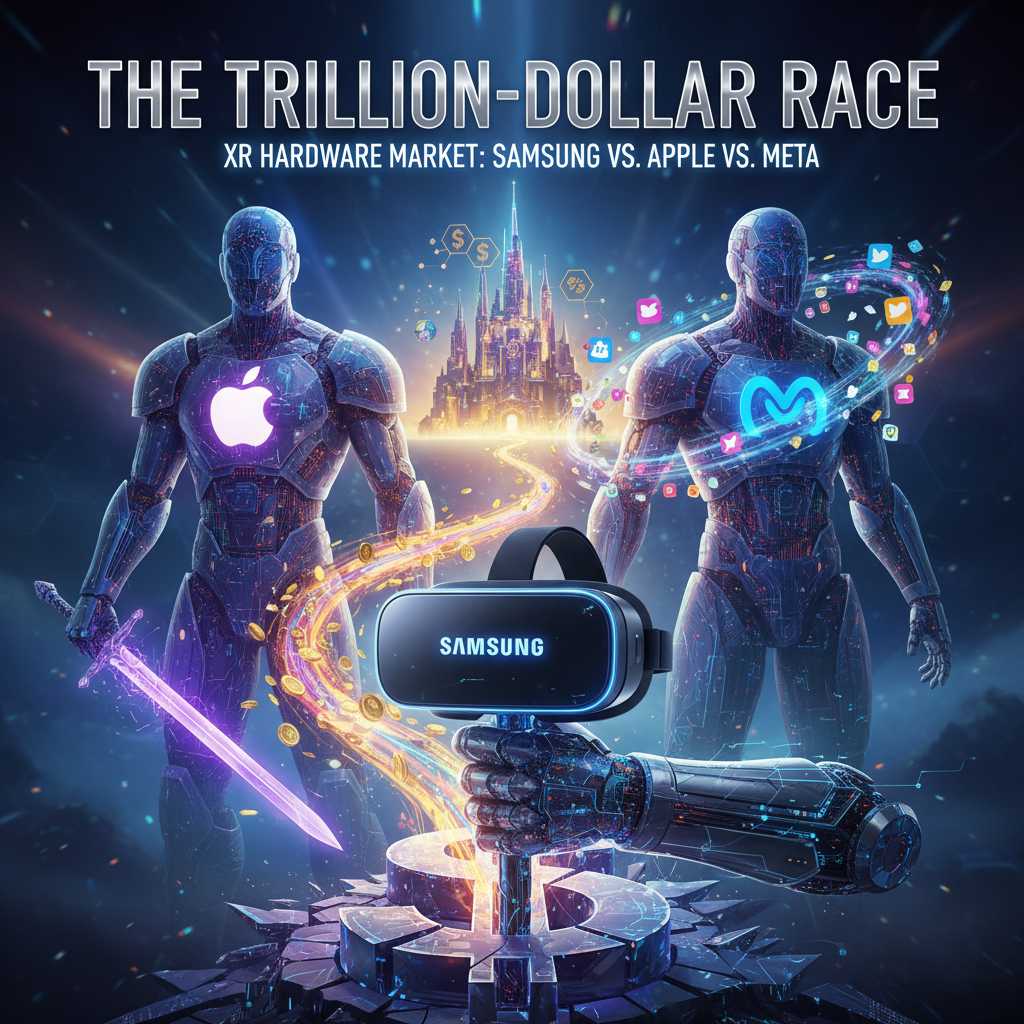A. The Strategic Imperative: Redefining the Extended Reality Value Curve
The Core Problem
The Extended Reality (XR) hardware market, projected to soar past $85 billion by 2030 (a 33.16% CAGR), is currently stalled by two critical constraints: prohibitive entry cost at the premium end (Apple Vision Pro at ∼$3,499) and content scarcity driven by walled gardens. This prevents XR from moving beyond the novelty phase into genuine, sustained enterprise and prosumer utility.
Samsung’s calculated $1,799 launch price for the Galaxy XR—nearly 50% less than its chief competitor—doesn’t just enter the market; it instantly defines the highly lucrative ‘Prosumer Sweet Spot’ and forces a fundamental, permanent recalibration of premium XR hardware valuation.
The single most important action Investors and CEOs must take is recognizing that the Android XR Open Ecosystem, powered by Gemini AI, represents the only viable, scalable software platform positioned to capture long-term, high-volume market share and convert the forecasted multi-billion-dollar enterprise opportunity.
This is essential reading for Investors, CEOs, and technology strategists making capital allocation decisions in the future of computing.
B. The Data Breakdown for the XR Hardware Battle
Samsung’s strategy is a focused counter-attack leveraging superior hardware specs where it matters most for productivity and comfort, coupled with an open-source software advantage.
1. The Prosumer Sweet Spot: Price-to-Performance Superiority
The strategic price differential establishes a new, premium tier below the ultra-premium leader. The Galaxy XR is priced at $1,799, compared to the Apple Vision Pro (AVP) at ∼$3,499. This near-50% cost reduction is a critical financial lever for adoption.
The Galaxy XR delivers a higher total pixel count of 29 million (through dual 4K Micro-OLED displays) compared to AVP’s 23 million. Furthermore, its weight of 545g makes it substantially lighter than the AVP’s 600–750g+.
This price point validates high-fidelity use cases (e.g., design, engineering) for large enterprises by making bulk adoption economically feasible—a direct 50% cost reduction on capital expenditure. The increased pixel density is also the cornerstone of prosumer and enterprise productivity, ensuring superior text readability and visual clarity for sustained work sessions.
Case in Point: A design firm evaluating 50 units for its 3D modeling team must weigh the superior technical clarity and reduced cost of the Galaxy XR against the raw computational power of the AVP. The price-to-performance ratio of the Galaxy XR, coupled with its lighter design, directly addresses the need for both budget stability and user comfort during long, intensive creative sessions.
I asked the Meta Quest 3 CEO how he felt about the Galaxy XR undercutting Apple. He said, “I don’t mind. I like being the budget option—it’s the closest thing I have to a profit margin right now.”
2. The Ecosystem War: OpenXR and Content Velocity
The Android XR Platform is a collaborative, OpenXR-based operating system designed to overcome content scarcity—the primary challenge facing the entire high-end XR market.
Android XR, developed with Google and Qualcomm, grants instant access to millions of existing 2D Android apps “out of the box” and offers full support for open standards like OpenXR and Unity 6.
The “out of the box” content and OpenXR standard eliminate the largest barrier to developer adoption. This accelerates the B2B pipeline, making it easier for Enterprise ISVs (Independent Software Vendors) to port and deploy complex industrial training and collaboration tools with minimal effort.
Case in Point: By leveraging Snapdragon Spaces and OpenXR, the platform immediately supports secure, enterprise-grade applications. For instance, a construction firm can quickly deploy existing Android manuals and collaborate in AR using the OpenXR standard, bypassing the usual multi-year proprietary development cycle required by closed, vertical systems.
3. Hardware Market Dynamics: Enterprise as the Revenue Anchor
The XR market’s overall trajectory involves massive growth, but also a shift in where that value is generated. The Global XR Market Size is forecasted to reach $85.56 Billion by 2030 (33.16% CAGR).
While consumer demand drives unit volume, the Industrial & Manufacturing sector is the largest segment and is expected to drive 60% of total VR revenue by 2030. The current market is heavily skewed toward affordability, with Meta Platforms commanding 74.6% – 77% of unit market share.
This massive growth projection validates capital investment, but the revenue focus must be on the Enterprise sector. Samsung’s emphasis on comfort (545g weight) and high resolution directly addresses the needs of industrial users requiring sustained, full-shift use. Samsung’s strategic goal is to capture a significant portion of the value segment, as Apple’s ultra-high price limits its unit market share.
Case in Point: The Asia-Pacific region, the fastest-growing market (35.1% CAGR), is driven by large-scale manufacturing digitization. Samsung’s native strength and strategic focus on enterprise applications (leveraging the Snapdragon Spaces platform) are perfectly positioned to capitalize on this high-velocity, high-value regional shift.
The CEO was so excited about the XR market reaching $500 billion, he tried to host his entire board meeting in the metaverse. Unfortunately, he forgot to charge his external battery pack and the meeting lasted 15 minutes.
C. The Strategic Implication
Samsung’s deep integration of Gemini AI transforms the Galaxy XR from a display into a true multimodal computing platform, fundamentally raising the bar for utility and setting the strategic direction for all future high-end hardware.
4 Actionable Recommendations
- Prioritize Android XR Vertical Integration: Immediately establish an internal Enterprise Software Vendor (ISV) team focused exclusively on the Android XR and OpenXR ecosystem. This guarantees day-one readiness for the multi-million app content pool and captures the accelerated developer momentum.
- Benchmark on Comfort and Clarity: When evaluating capital expenditure for XR device deployment, mandate technical specifications that prioritize sustained use. Prioritize devices like the Galaxy XR that deliver superior pixel density (4,032 PPI) and minimized weight (545g) over raw, battery-draining processing power.
- Deploy AI-Native Productivity Pilots: Focus internal pilot programs not on entertainment, but on AI-driven utility. Use the Gemini Live feature for real-time coaching, contextual workflow assistance, and multimodal spatial computing to prove measurable productivity gains in manufacturing, engineering, or design.
- Capitalize on the Prosumer Sweet Spot: Target market entry and expansion in the $1,500-$2,000 price segment. This is the highest-value market void, offering the premium specifications necessary for enterprise adoption without the financial friction of the ultra-premium ($3,500) tier.
Risk Mitigation: The Performance vs. Utility Trade-Off
The common mistake is over-indexing on raw processing speed (Apple’s M-series chip) as the primary adoption metric. While the AVP boasts superior 120Hz refresh rates and raw compute, the long-term success of the platform hinges on daily utility, comfort, and content library. Enterprises must avoid the “Ferrari effect”—buying a powerful machine that sits idle due to a lack of compatible, useful software or poor user ergonomics. The Snapdragon-powered, open-ecosystem approach mitigates the risk of a hardware investment becoming a content island.
Future Outlook (12–18 Months)
The next 12–18 months will see Android XR establish itself as the dominant, multi-OEM software standard for the $1,000+ headset category. This open-source success will force Apple to either significantly reduce its pricing or accelerate the development of a proprietary enterprise-specific application suite to justify its hardware premium. Furthermore, the focus will shift from headsets to lighter, AI-native AR glasses integrated with Gemini, accelerating the industry toward the higher $500 Billion-plus by 2032 market projections.
D. Methodology/Source Note (Authority Builder)
This analysis is based on a strategic review of the Samsung Galaxy XR launch materials, head-to-head technical benchmarking, and a synthesis of proprietary market sizing and CAGR data from leading Extended Reality (XR) industry analysts (2024–2032 forecasts).
E. Questions/Answers
Q: What is Samsung’s key strategy to challenge the Apple Vision Pro (AVP) market share?
A: Samsung’s key strategy is defining the “Prosumer Sweet Spot” by pricing the Galaxy XR at $1,799, undercutting the AVP by nearly 50%. This price-to-performance superiority leverages a higher pixel count (29M vs. AVP’s 23M) and a lighter form factor (545g) for superior enterprise utility.
Q: What is the significance of the Android XR platform in the market competition?
A: Android XR is an OpenXR-based platform that immediately solves the industry’s content scarcity problem. It provides day-one access to millions of existing 2D Android apps and facilitates rapid developer adoption, directly challenging the closed, “walled garden” limitations of proprietary ecosystems.
Q: Why is the Industrial & Manufacturing sector crucial to the future of the XR market?
A: While gaming drives unit volume, the Industrial & Manufacturing sector is the most valuable segment and is projected to drive 60% of total VR revenue by 2030. This confirms that the long-term financial stability of the XR market relies heavily on secure, utilitarian, and enterprise-grade hardware and software solutions.
Q: How does Gemini AI integration change the value proposition of the Galaxy XR?
A: The deep integration of Gemini Live (AI) transforms the Galaxy XR into a multimodal productivity tool. It offers real-time, context-aware assistance through voice, vision, and gesture, solidifying the device’s claim to deliver enduring, practical utility beyond mere entertainment or novelty.
Q: What is the fastest-growing region for the XR hardware market?
A: While North America currently holds the largest revenue share, the Asia-Pacific region is projected to be the fastest-growing market, with a forecasted CAGR of 35.1%, fueled by 5G rollouts and large-scale manufacturing digitization initiatives.
F. Conclusion
The Galaxy XR has permanently redefined the premium XR landscape, proving that superior display fidelity and an open, AI-native ecosystem can be delivered at half the cost of the ultra-premium alternative.
The successful scaling of the XR market to its multi-billion-dollar potential hinges not on raw proprietary compute, but on the utility and accessibility guaranteed by the OpenXR standard and AI integration.
To evaluate the economic impact of enterprise XR deployment, download our proprietary ROI calculator for the sub-$2,000 headset tier and share this analysis with your hardware procurement team.




